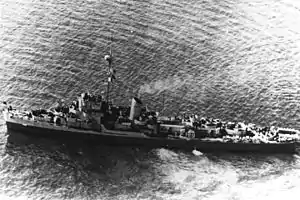USS Frederick C. Davis
USS Frederick C. Davis (DE-136) was an Edsall-class destroyer escort built for the United States Navy during World War II. Named for Ensign Frederick Curtice Davis (a naval aviator who was killed during the Japanese attack on Pearl Harbor), she was the first U.S. Naval vessel to bear the name. She was the last US Naval vessel lost in the Battle of the Atlantic.
 USS Frederick C. Davis (DE-136) at sea | |
| History | |
|---|---|
| Name: | Frederick C. Davis |
| Namesake: | Frederick Curtice Davis |
| Builder: | Consolidated Steel Corporation, Orange, Texas |
| Laid down: | 9 November 1942 |
| Launched: | 24 January 1943 |
| Commissioned: | 14 July 1943 |
| Fate: | Sunk by U-546, 24 April 1945 |
| General characteristics | |
| Class and type: | Edsall-class destroyer escort |
| Displacement: |
|
| Length: | 306 ft (93.3 m) |
| Beam: | 36.58 ft (11.1 m) |
| Draft: | 10.42 ft (3.2 m) full load |
| Propulsion: |
|
| Speed: | 21 knots (39 km/h; 24 mph) |
| Range: | 9,100 nmi (16,900 km; 10,500 mi) at 12 knots (22 km/h; 14 mph) |
| Complement: | 8 officers, 201 enlisted |
| Armament: |
|
History
Frederick C. Davis was laid down on 9 November 1942 by the Consolidated Steel Company of Orange, Texas that was launched on 24 January 1943, sponsored by Mrs. Dorothy H. Robins. The ship was commissioned on 14 July 1943 with Lieutenant Commander O. W. Goepner, USNR, in command. Frederick C. Davis sailed from Norfolk on 7 October 1943 to escort a convoy to Algiers. She was assigned to escort duty between North African ports and Naples, and on 6 November first came under enemy air attack. A wave of torpedo and medium bombers damaged three ships in her convoy but were driven off by the escort's anti-aircraft fire before further damage could be done. Again under air attack on 26 November, Frederick C. Davis splashed at least two of the enemy aircraft.
Continuing her escort duty in the western Mediterranean Sea, Frederick C. Davis took part in an attack on 16 December 1943 which resulted in the sinking of U-73 by two of her group. On 21 January 1944 the escort sortied from Naples for the Anzio landings, during which her superlative and courageous performance was to win her a Navy Unit Commendation. After providing protection from submarines and aircraft to ships giving fire support to the assault on 22 January, Frederick C. Davis maintained a patrol off the besieged beachhead for the next six months, leaving only for brief periods of replenishment at Naples. Equipped with special equipment to jam the control frequency of the enemy's rocket-propelled, radio-directed glider bombs, Frederick C. Davis fought off enemy air attacks, protecting shipping in the anchorage and the men enduring the fighting ashore. Particularly during the earlier stages of this bitter operation, Frederick C. Davis came under shellfire from shore batteries. Shrapnel caused slight damage to the ship, but only one man was wounded during this service.
.jpg.webp)
Loss
After a return to escort duty in the Mediterranean in June and July 1944, Frederick C. Davis cleared Naples on 9 August for Corsica, her staging point for the assault on southern France. Here again she provided her special jamming services to protect the headquarters ship for the operation, USS Catoctin. She remained off the assault area on anti-submarine patrol and controlling shipping until 19 September, then returned to New York Navy Yard for overhaul. Returning to duty in the western Atlantic early in 1945, Frederick C. Davis served on coastal convoy escort and anti-submarine patrol service and in mid-April joined a special surface barrier force, formed to protect the Atlantic coast from the threat of close penetration by snorkel-equipped German submarines during Operation Teardrop. It was one of these, U-546, which was contacted 24 April by Frederick C. Davis. Within minutes, as the destroyer escort prepared to attack, the submarine torpedoed her, hitting on the port side, forward. Five minutes later, she broke in two, and efforts to preserve the buoyancy of the stern, where the damage was less and the majority of survivors were located, failed. Her survivors abandoned the ship, with a loss of 115 men. They were taken from the water within three hours, and other escorts sank her attacker the same day.
Awards
See also
- See List of U.S. Navy losses in World War II for other Navy ships lost in World War II.
- USS Davis for ships with a similar name.
References
- This article incorporates text from the public domain Dictionary of American Naval Fighting Ships. The entry can be found here.
- "Frederick C. Davis". Dictionary of American Naval Fighting Ships. Retrieved 21 March 2007.
- "DE-136 USS Frederick C. Davis". Destroyer Escort Photo Archive. Retrieved 21 March 2007.
External links
- ‘A Brotherhood Of Survivors’: WWII veteran recalls rescue at sea.
- 'Website dedicated to the ship and crew' at www.ussfrederickdavis.com